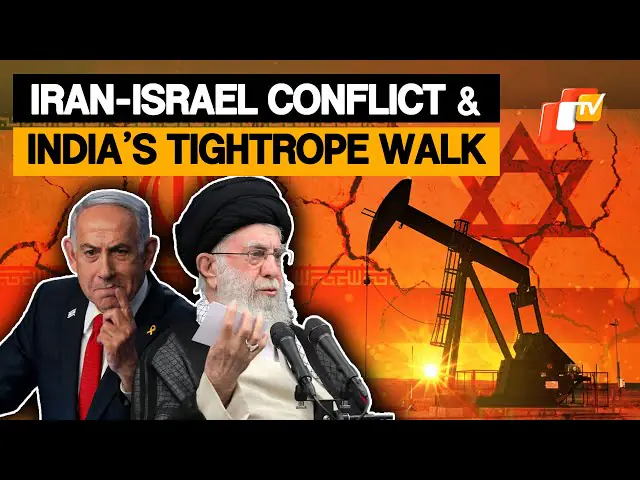🌍 Introduction
Iran–Israel Conflict 2025 has captured global attention, intensifying tensions across the Middle East and reshaping the region’s security dynamics. This is not an isolated or sudden war — it is the result of decades of rivalry, religious tensions, ideological divides, and complex geopolitical interests. From covert proxy battles to direct confrontations, the war has evolved from a simmering rivalry into an open, multidimensional conflict that threatens global stability. In this article, we break down the key events of 2025, the main causes of the conflict, and its global implications, providing a comprehensive understanding for readers seeking to comprehend the turbulent dynamics of this crisis.

http://yoursite.com/middle-east-conflicts
http://yoursite.com/irans-nuclear-program
http://yoursite.com/israel-iran-history
🕵️♂️ ₹300 crore Ponzi scam in Maharashtra: The Full Story of Selva Kumar Nadar
Breaking Down the Explosive Iran Israel War 2025: Timeline, Causes & Global Fallout
🕓 Iran–Israel Conflict Timeline of Events in 2025
🔹 January 2025: The Spark
The war began with an Israeli airstrike in Syria that killed a senior commander of Iran’s Revolutionary Guard Corps. The attack, allegedly aimed at disrupting weapons transfers, was met with fiery vows of retaliation from Tehran. Iran announced that Israel would face “serious and painful” consequences, triggering fears of a regional escalation.
🔹 February 2025: New Weapons Enter the Fray
Iran responded by allegedly supplying advanced drones and precision-guided missiles to its allied militant groups, including Hezbollah and Hamas. In turn, Israel intensified its air raids in southern Lebanon and Gaza. Border clashes surged as both sides mobilized troops and strengthened fortifications, sparking alarm across the Middle East.
🔹 March 2025: The Conflict Spreads
The war expanded as cross-border rocket attacks between Israel and Hezbollah became almost daily occurrences. Civilians were evacuated from border towns, and international alarm grew. Israel launched precision airstrikes against weapons shipments and bases in Syria and Lebanon, aiming to disrupt Iran’s supply lines to its proxy forces.
🔹 April 2025: Cyber Battles Begin
With tensions escalating, both nations launched major cyberattacks targeting critical infrastructure — from energy grids to air defense systems. Iran threatened a “disproportionate” response, hinting openly at direct missile strikes deep within Israeli territory.
🔹 May–June 2025: All‑Out Confrontation
The conflict entered its most dangerous phase as direct air and missile exchanges between Israel and Iran intensified. The United Nations, the United States, the European Union, Russia, and Arab nations called urgently for a ceasefire and de‑escalation. Meanwhile, regional powers like Saudi Arabia and the United Arab Emirates tried to contain the crisis from spreading beyond the Middle East.
🔥 Main Causes of the Conflict
1️⃣ Iran’s Nuclear Ambitions
Israel has long viewed Iran’s nuclear program as an existential threat. The possibility of a nuclear-armed Iran has shaped Israel’s security policies for years and acted as a catalyst for tensions that erupted into open conflict.
2️⃣ Regional Proxy Wars
Iran supports militant groups such as Hezbollah and Hamas to build a “resistance network” across the Middle East. In response, Israel has conducted pre‑emptive strikes to neutralize these threats, making a direct war almost inevitable.
3️⃣ Geopolitical Rivalry
Both nations seek dominance in the Middle East. Iran aims to expand its influence across Iraq, Syria, Lebanon, and Yemen, while Israel strives to maintain military superiority and protect its borders. This competition has turned into a high‑stakes conflict that draws in other regional and global powers.
4️⃣ Ideological Divide
The deep-seated tensions between the Jewish State of Israel and the Islamic Republic of Iran fuel mistrust and aggression. Ideology intertwines with national interests, making this conflict more than just a war over borders or resources — it is a struggle of identity and survival.
🌍 Why This Conflict Matters Globally
The Iran–Israel Conflict of 2025 threatens global stability in profound ways:
Energy Impact: The Middle East supplies a significant portion of the world’s oil and gas. An extended conflict could disrupt global supply chains, causing oil prices to spike and triggering economic instability.
Regional Spillover: The war risks drawing in global powers such as the US, Russia, and EU, and could potentially destabilize neighboring Arab nations.
Security Challenges: The conflict has heightened global terror alerts and increased the threat of cyber and missile attacks beyond the Middle East.
Economic Fallout: Trade routes, energy corridors, and global markets are highly susceptible to disruption as tensions rise Iran–Israel Conflict 2025.
✅ Conclusion: Understanding the Bigger Picture
The Iran–Israel Conflict of 2025 is not just another Middle Eastern war — it is a clash of ideology, national interests, and regional aspirations that affects the security and prosperity of the entire globe. Understanding its timeline, root causes, and wider implications is vital for making sense of the turbulent dynamics reshaping the Middle East. As tensions evolve, the world watches closely, hoping for a path toward dialogue, de‑escalation, and long‑term peace Iran–Israel Conflict 2025.